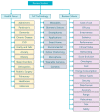IoT Wearable Sensors and Devices in Elderly Care: A Literature Review
- PMID: 32429331
- PMCID: PMC7288187
- DOI: 10.3390/s20102826
IoT Wearable Sensors and Devices in Elderly Care: A Literature Review
Abstract
The increasing ageing global population is causing an upsurge in ailments related to old age, primarily dementia and Alzheimer's disease, frailty, Parkinson's, and cardiovascular disease, but also a general need for general eldercare as well as active and healthy ageing. In turn, there is a need for constant monitoring and assistance, intervention, and support, causing a considerable financial and human burden on individuals and their caregivers. Interconnected sensing technology, such as IoT wearables and devices, present a promising solution for objective, reliable, and remote monitoring, assessment, and support through ambient assisted living. This paper presents a review of such solutions including both earlier review studies and individual case studies, rapidly evolving in the last decade. In doing so, it examines and categorizes them according to common aspects of interest such as health focus, from specific ailments to general eldercare; IoT technologies, from wearables to smart home sensors; aims, from assessment to fall detection and indoor positioning to intervention; and experimental evaluation participants duration and outcome measures, from acceptability to accuracy. Statistics drawn from this categorization aim to outline the current state-of-the-art, as well as trends and effective practices for the future of effective, accessible, and acceptable eldercare with technology.
Keywords: AAL; Alzheimer’s; IoT; dementia; devices; elders; old age; sensors; wearables.
Conflict of interest statement
The authors declare no conflict of interest.
Figures











References
-
- Department of Economic and Social Affairs PD . World Population Ageing 2019. Nations Department of Economic; Bangkok, Thailand: 2019.
-
- Australia D., Baker S., Banerjee S. World Alzheimer Report 2019: Attitudes to Dementia. Alzheimer’s Dis. Int.; London, UK: 2019. Others Alzheimer’s Disease International.
-
- Alsheimer’s Disease Facts and Figures Includes a Special Report on Alzheimer’s Detection in the Primary Care Setting: Connecting Patients and Physicians. Alzheimer’s Dis. Int.; London, UK: 2019.
-
- Li R., Lu B., McDonald-Maier K.D. Cognitive assisted living ambient system: A survey. Digit. Commun. Netw. 2015;1:229–252. doi: 10.1016/j.dcan.2015.10.003. - DOI
Publication types
MeSH terms
Grants and funding
LinkOut - more resources
Full Text Sources
Medical

